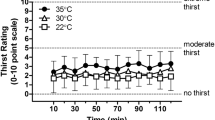Abstract
Early human ancestors evolved hunting in the midday heat on the dry African savannah and developed favourable biological adaptations that permit prolonged running in the heat. These physiological adaptations must have included the capacity to sweat profusely to maintain a low body temperature when running for 4–6 hours in dry heat, an absence of adverse consequences from developing mild to moderate fluid deficits caused by sweat losses during the hunt, a serum osmolality based thirst mechanism and the ability to ‘outrun their thirst’ (to resist the deleterious psychological and other effects of severe thirst). Until the early 1970s, the guidelines for fluid ingestion during exercise were not to drink and are consistent with this interpretation. By 1996, guidelines stated, “individuals should be encouraged to consume the maximal amount of fluids during exercise that can be tolerated without gastrointestinal discomfort up to a rate equal to that lost from sweating,” and this was interpreted by some as “to drink as much as tolerable.” This article argues that humans are designed to drink just enough to maintain plasma osmolality, not necessarily bodyweight, both at rest and during exercise. Drinking to maintain bodyweight may impair exercise performance by inducing a weight penalty and may increase the probability of exercise-associated hyponatraemia in slow marathon runners.
Similar content being viewed by others
References
Noakes TD. Fluid replacement during exercise. Exerc Sport Sci Rev 1993; 21: 297–330
Fotheringham W. Put me back on my bike: in search of Tom Simpson. London: Yellow Jersey Press, 2002
Noakes TD. Dehydration during exercise: what are the real dangers? Clin J Sport Med 1995; 5 (2): 123–8
Heinrich B. Racing the antelope. 1st ed. New York: Harper Collins Publishers Inc., 2001
Nadel ER, Wenger CB, Roberts MY, et al. Physiological defenses against hyperthernria of exercise. Ann N Y Acad Sci 1977; 301: 98–109
Greenleaf JE, Castle BL. Exercise temperature regulation in man during hypohydrefion and hyperhydration. J Appl Physiol 1971; 30 (6): 847–53
Nielsen B, Hansen G, Jorgenson SO, et al. Thermoregulation in exercising man during dehydration and hyperhydration with water and saline. Int J Bioneteorol 1971; 15: 195–200
Wyndham CH. Heat stroke and hyperthernia in marathon runners. Ann N Y Acad Sci 1977; 301: 128–38
Costill DL. Sweating: its composition and effects on body fluids. Ann N Y Acad Sci 1977; 301: 160–74
Cade R, Spooner G, Schlein E, et al. Effect of fluid, electrolyte, and glucose replacement during exercise on performance, body temperature, raic of sweat loss, and compositional changes of exuacellular fluid. J Sports Med Phys Fitness 1972; 12 (3): 150–6
Montain SJ, Coyle EF. Influence of graded dehydration on hypextherntia and cardiovascular drift during exercise. J Appl Physiol 1992; 73 (4): 1340–50
Convertion VA, Armstrong LE, Coyle EL et al. American College of Sports Medicine position stand: exercise and fluid replacement. Med Sci Sports Exerc 1996; 28: i–vii
Noakes TD. Drinking guidelines for exercise: what is the evidence that athletes should either drink “as much as tolerable” or “to replace all the weight lost during exercise” or “ad libitum”. J Sports Sci. In press
Sharwoorl KA, Collins M, Goedecke JH, et al. Weight changes, medical complications, and performance during an Ironman triathlon. Br J Sports Med 2004; 38 (6): 718–24
Hew-Butler TD, Verbalis JG, Noakes TD. Updated fluid recommendation: posmon statement from the International Marathon Medical Directors Association (IMMDA). Clin J Sport Med 2006; 16 (4): 283–92
Acknowledgements
The author’s research, on which this review is based, is funded by the Medical Research Council of South Africa, the Harry Crossley and Nellie Atkinson Staff Research Funds of the University of Cape Town, Discovery Health and the National Research Foundation of South Africa through its THRIP initiative. Timothy D. Noakes is a contracted researcher for Bromar Foods Pty Ltd.
Author information
Authors and Affiliations
Corresponding author
Rights and permissions
About this article
Cite this article
Noakes, T.D. Hydration in the Marathon. Sports Med 37, 463–466 (2007). https://doi.org/10.2165/00007256-200737040-00050
Published:
Issue Date:
DOI: https://doi.org/10.2165/00007256-200737040-00050




